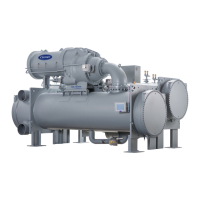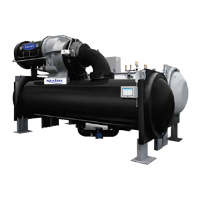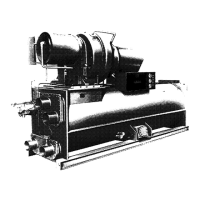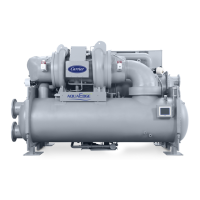Check Oil Pressure and Compressor Stop
1. When the motor is at full speed, note the differential oil
pressure reading on the CVC default screen. It should be
between 18 and 30 psid (124 to 206 kPad).
2. Press the Stop button and listen for any unusual sounds
from the compressor as it coasts to a stop.
To Prevent Accidental Start-Up — A chiller STOP
override setting may be entered to prevent accidental start-up
during service or whenever necessary. Access the MAIN-
STAT screen and using the NEXT
or PREVIOUS soft-
keys, highlight the CHILLER START/STOPparameter. Override
the current START value by pressing the SELECT
softkey.
Press the STOP
softkey followed by the ENTER softkey.
The word SUPVSR! displays on the CVC indicating the over-
ride is in place.
To restart the chiller the STOP override setting must be
removed. Access the MAINSTAT screen and using
NEXT
or PREVIOUS softkeys highlight CHILLER
START/STOP. The 3 softkeys that appear represent 3 choices:
•START
— forces the chiller ON
•STOP— forces the chiller OFF
• RELEASE — puts the chiller under remote or schedule
control.
To return the chiller to normal control, press the
RELEASE
softkey followed by the ENTER softkey. For
more information, see Local Start-Up, page 44.
The default LID screen message line indicates which com-
mand is in effect.
Check Chiller Operating Condition — Check to
be sure that chiller temperatures, pressures, water flows, and
oil and refrigerant levels indicate the system is functioning
properly.
Instruct the Customer Operator — Ensure the
operator(s) understand all operating and maintenance pro-
cedures. Point out the various chiller parts and explain their
function as part of the complete system.
COOLER-CONDENSER — Float chamber, relief valves, re-
frigerant charging valve, temperature sensor locations, pres-
sure transducer locations, Schrader fittings, waterboxes and
tubes, and vents and drains.
OPTIONAL PUMPOUT STORAGE TANK AND PUMP-
OUT SYSTEM — Transfer valves and pumpout system,
refrigerant charging and pumpdown procedure, and relief
devices.
MOTOR COMPRESSOR ASSEMBLY — Guide vane
actuator, transmission, motor cooling system, oil cooling
system, temperature and pressure sensors, oil sight glasses,
integral oil pump, isolatable oil filter, extra oil and motor
temperature sensors, synthetic oil, and compressor
serviceability.
MOTOR COMPRESSOR LUBRICATION SYSTEM — Oil
pump, cooler filter, oil heater, oil charge and specification,
operating and shutdown oil level, temperature and pressure,
and oil charging connections.
CONTROLSYSTEM — CCN and LOCAL start, reset, menu,
softkey functions, CVC operation, occupancy schedule, set
points, safety controls, and auxiliary and optional controls.
AUXILIARYEQUIPMENT— Starters and disconnects, sepa-
rate electrical sources, pumps, and cooling tower.
DESCRIBE CHILLER CYCLES — Refrigerant, motor cool-
ing, lubrication, and oil reclaim.
REVIEW MAINTENANCE — Scheduled, routine, and
extended shutdowns, importance of a log sheet, importance
of water treatment and tube cleaning, and importance of main-
taining a leak-free chiller.
SAFETY DEVICES AND PROCEDURES — Electrical dis-
connects, relief device inspection, and handling refrigerant.
CHECK OPERATOR KNOWLEDGE — Start, stop, and shut-
down procedures, safety and operating controls, refrigerant
and oil charging, and job safety.
REVIEW THE START-UP, OPERATION, AND MAINTE-
NANCE MANUAL.
OPERATING INSTRUCTIONS
Operator Duties
1. Become familiar with the chiller and related equipment
before operating the chiller.
2. Prepare the system for start-up, start and stop the chiller,
and place the system in a shutdown condition.
3. Maintain a log of operating conditions and document any
abnormal readings.
4. Inspect the equipment, make routine adjustments, and per-
form a Control Test. Maintain the proper oil and refrig-
erant levels.
5. Protect the system from damage during shutdown
periods.
6. Maintain the set point, time schedules, and other PIC
functions.
Prepare the Chiller for Start-Up — Follow the steps
described in the Initial Start-Up section, page 58.
To Start the Chiller
1. Start the water pumps, if they are not automatic.
2. On the CVC default screen, press the LOCAL
or
CCN
softkey to start the system. If the chiller is in the
OCCUPIED mode and the start timers have expired, the
start sequence will start. Follow the procedure described
in the Start-Up/Shutdown/Recycle section, page 44.
Check the Running System — After the compres-
sor starts, the operator should monitor the CVC display and
observe the parameters for normal operating conditions:
1. The oil reservoir temperature should be above 120 F
(49 C) during shutdown and above 125 F (58 C) during
compressor operation.
2. The bearing oil temperature accessed on the COM-
PRESS table should be 120 to 165 F (49 to 74 C). If the
bearing temperature reads more than 180 F (83 C) with
the oil pump running, stop the chiller and determine the
cause of the high temperature. Do not restart the chiller
until corrected.
3. The oil level should be visible anywhere in one of the
two sight glasses. Foaming oil is acceptable as long as
the oil pressure and temperature are within limits.
4. The oil pressure should be between 18 and 30 psid
(124 to 207 kPad) differential, as seen on the CVC de-
fault screen. Typically the reading will be 18 to 25 psid
(124 to 172 kPad) at initial start-up.
5. The moisture indicator sight glass on the refrigerant
motor cooling line should indicate refrigerant flow and a
dry condition.
6. The condenser pressure and temperature varies with
the chiller design conditions. Typically the pressure will
range between 100 and 210 psig (690 to 1450 kPa)
59

